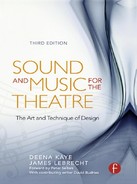Introduction to the Third Edition
Sound design. The very words sound odd. Who designs sound? And why would you need to? Orators from the past apparently designed it in the way they spoke, or listeners were far keener than they are today: Lincoln delivered the Gettysburg Address to 9000 people. Without a microphone. Outdoors. Long before that there was Epidaurus. Thousands of spectator-listeners listening to, occasionally, whispers from the masked actors. Catharsis ensued, by all accounts.
What has changed? In terms of listening, in terms of hearing — almost everything. We hear differently now. And the sound designer helps us hear the insides of a play, from the way a door is opened offstage to the breeze we hear outside an onstage window. The sound designer focuses our ears on a moment or a place, assisting the rest of the design team. For instance, the set looks like an apartment. The sound designer can let us know if the apartment is in a city; if there are noisy neighbors upstairs or in the hallway; if something is cooking on the stove; or if a bird is singing in its cage. But the design of those rather mundane sounds can key us into the way the playwright and the director want the play to begin psychologically.
We might have a scene set in the outdoors. If we are after a foreboding feel, what sort of birds should we hear? Sparrows? Songbirds? Or … crows? And if it’s twittering birds we’re after, how can the designer make the audience know that those birds are not stuck in the rafters of the playhouse, but rather in the aural design of the play itself?
We need sound design to focus the ears of the watchers just as acutely as the lighting design focuses their eyes. We need it to enhance not only the volume of a spoken line, but also the sounds around the drama and inside it. Sound design can build suspense, can focus a spoken moment, and can direct the ear to listen with more care. Film has been in the forefront of this technology, and in the last three decades, sound design has entered the live theater with exciting results and some dazzling technology. So now the entire enterprise of presenting and making theater is enriched — indeed enhanced by the subtle psychology that the sound designer invests into the whole matrix of the final grand design of a production. Now sound designers collaborate with the visual designers, and they are also one-on-one with the sound that comes from the actors. Sound design interacts with every single aspect of a production.
The best sound designers I’ve worked with bring me in touch with whatever show I’m working on in a whole new way; they bring another perspective to my work and literally show me ideas through sound. Ideas I was either unconscious of or that I didn’t possess before discussions. Each designer illuminates the play, and the finest collaborators understand in how many infinite ways their contributions intersect and interact. Sound and light work together all through a performance, whether it is something as simple as the music playing as a curtain is going up or as complicated as a wood near Athens infested with fairies on a midsummer’s night.
Sound design is one of the richest tools at our disposal for making the piece say what we want it to, both literally and psychologically. From the choice of music to collaboration with a composer, from the sounds that come from the actors to the sounds created to give power and meaning to the play’s environment, both its spiritual as well as its geographical one, everything is now impacted, indeed enhanced in all senses, by sound design. It is now, thanks to the work of many, an art form.
I am pleased to introduce you to this new edition of a book that has been used for many years to enlighten sound designers, composers, and directors to the world that I embrace so heartily. Thank you, Deena and James!
Mark Lamos
November 2008
